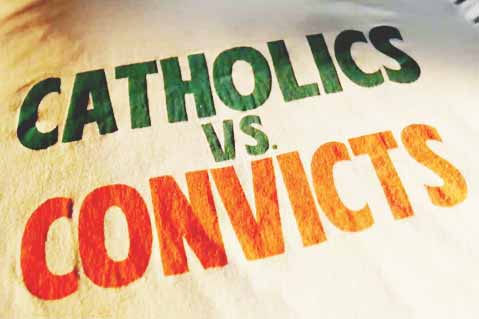Commentary December 27, 2016
Counselor Commentary: How a T-shirt Ignited One of Football’s Biggest Rivalries
ESPN’s latest entry in its acclaimed 30 for 30 series is a two-hour documentary about a T-shirt. But it’s also about so much more: religion, racial stereotypes, the cultural divide of the 1980s and a slow-burning fire of a college football rivalry that suddenly ignited white hot and then burned out just as quickly. The fact that a printed white T-shirt sat at the center of this storm offers a telling lesson for our industry.

Quick background: ESPN’s film is about the 1988 game between Notre Dame and Miami, two of college football’s superpowers at the time and bitter rivals. The public perceptions of the two schools and their programs could not have been any farther apart. Notre Dame: history, Catholicism, academics and (very) white. Miami: upstarts, brash and (for the football team) predominantly black.
Meanwhile, the film tells another story couched in the nascent days of T-shirt entrepreneurship on college campuses. It’s an inside job on the part of the filmmaker: director and narrator Patrick Creadon was a Notre Dame student at the time, and his best friend and roommate Pat Walsh was the T-shirt king of the university, peddling the designs and pop culture riffs that college students today still gobble up by millions.
The worlds collide with a T-shirt. The front of the shirt was standard game day hype, but it was the wording on the back that stirred the pot: “Catholics vs. Convicts.” It’s also the namesake of the movie, and as Creadon’s narration summarizes at the very beginning of the film: “Ten thousand stitches. One fluid ounce of ink. And 19 letters. That was the match that lit an already bitter rivalry on fire.”
The T-shirt was a major hit on the Notre Dame campus. But it went much bigger. Mainstream publications from across the country wrote stories about the T-shirt. The shirt crystallized the Notre Dame-Miami rivalry – which had escalated to an all-out feud with nothing less than the national title on the line – into a single pithy catchphrase. To this day the slogan still defines the rivalry.
One shirt didn’t start the Notre Dame-Miami rivalry, but it was the nitro boost for a car already speeding wildly. In the course of the film, Miami players, coaches and fans react viscerally to the shirt, and their displeasure is still palpable even decades later. The shirt was popular because it cheekily tapped into the broadest classifications of both schools, but underneath there was a deeper, harder sentiment that it extracted.
The film is catnip for sports fans, as it tells the story of one of college football’s greatest games. It also mines surprising stakes out of Walsh, who puts his dream of becoming a college athlete on the line by producing thousands of the shirts behind the scenes. The idea for the shirt wasn’t Walsh’s, but it reinforces the pivotal – and culpable – role that distributors play in facilitating ideas.
Most importantly for promotional product people, Catholics vs. Convicts reinforces a simple lesson. Promotional products have power. At their zenith, they carry messages that radiate across the land. They influence people and reinforce perceptions – for good or bad. Considering what you all do for a living, maybe we don’t need to be reminded of that. For the rest of us, let’s ignore the impulse to minimize what promotional products can do. The sky’s the limit.
